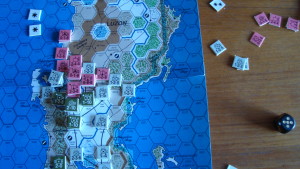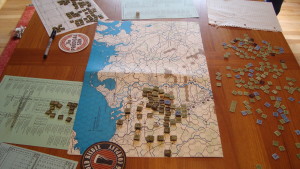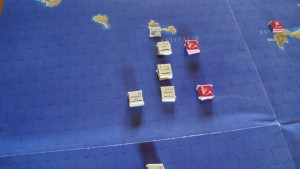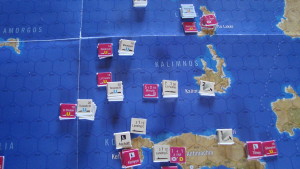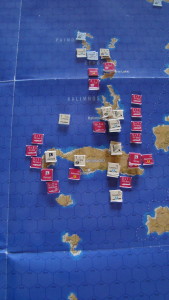Friend gone, weather bad, so why not another try? Set up same as before, except this time the C/G mechanized unit is adjacent to the airfield.
After Action Report
Turn 1 (Night)
SEALs land and spirit away the Governor-General. I can’t see how the C/G forces can prevent this given initial set-up restrictions.
Rangers conduct a night drop to avoid C/G units moving onto or adjacent to the airfield and really making things difficult during daylight. The Ranger drop is good, only the mortar platoon scatters. It lands on top of another unit and is disorganized. The drop is opposed by AAA fire (which increases drop DRM to -2). Because of this, the AAA units are revealed and attacked by air, but with no success.
C/G forces counterattack the Ranger company stacked with the disorganized mortar unit. The assaulting mechanized and motorized units can attack at full strength, with the infantry launching a hasty assault at half strength. The C/G mortar unit supports this 2:1 attack. The US player is lucky, with a D1 result rather than R, which would have left the C/G player in control of the field.
Turn 2 (Daylight)
The SEAL unit lands to rescue the students at Prickly Bay. No luck, it’s a dummy counter.
The Rangers counterattack one of the C/G units. C/G AAA is extremely effective. Odds are reduced to 6:1 with two shifts left for vegetation. The result is a D2. The C/G unit is disorganized and must retreat one hex. The Ranger company reorganizes, the mortar platoon does not.
C/G units retreat from the Ranger ZOCs and will now have to be spotted. Militia units move to occupy the two northern hexes containing students (or dummy students).
Turn 3 (Daylight)
The Rangers attack the disorganized C/G unit. AAA fire attrits supporting air (More 6s!!). However, the AAA units are now revealed and a follow up strike destroys one AAA unit. The Ranger attack works out as a 4-1, with one shift left. The die roll is a 5, for a D result, which eliminates the C/G unit. Meanwhile, the SEALs have located an unguarded student group at Anse Bay. They are airlifted to Salines Airfield. The Ranger mortar unit now reorganizes.
C/G units launch a furious counterattack with all available units. The target is one Ranger unit. The odds are 2:1 with two shifts left for vegetation. The die roll of 2 has no effect on the Rangers. The surviving AAA unit retreats northwest.
Turn 4 (Daylight)
The students are airlifted from Salines. The tireless SEALS land at St. Georges, moving to the north of the two C/G units babysitting the students. The Rangers move to attack C/G units north of the airfield. Since the Rangers are moving to contact, the C/G units are considered to be spotted. AAA fire attrits three out of the eight attacking aircraft units. The 3:2 odds are shifted two left due to vegetation. The attack results in a Contact, which halves the C/G units’ action points. Elements of the 82nd Airborne land at Salines Airfield and move towards the C/G units.
The C/G mechanized, motorized, AAA and mortar units withdraw up the coastal road to link up with units co-located with the students. One 2-4-4 unit is left to delay the US forces. However, the ever-dangerous AAA unit can now support the units guarding the students.
Turn 5 (Daylight)
The SEALs locate the last student group and attack. This is a hasty attack, but with overwhelming air support. For once, AAA fire is ineffective. The C/G unit is eliminated, without the students being harmed. The students are evacuated to Salines Airfield. The C/G player should have moved into the jungle to take advantage of the terrain. The Rangers, reinforced by the 82nd Airborne, ZOC up the delaying unit north of the airfield, and attack at 4:1, with two shifts to the left due to vegetation. The result is a Contact.
The C/G commander leaves the delaying unit to its fate, and moves his mechanized, motorized, AAA and mortar units to Fort Audodat. The two surviving militia units move north towards St. Georges. With the airfield taken, Governor General and students evacuated, all that is left to the C/G commander is to buy time and lure US forces into an ill-advised attack. The loss of one US unit will make this a close game.
What might pass for analysis will follow…..
